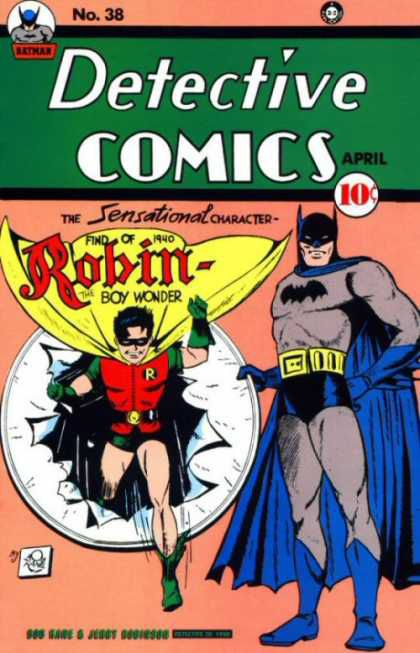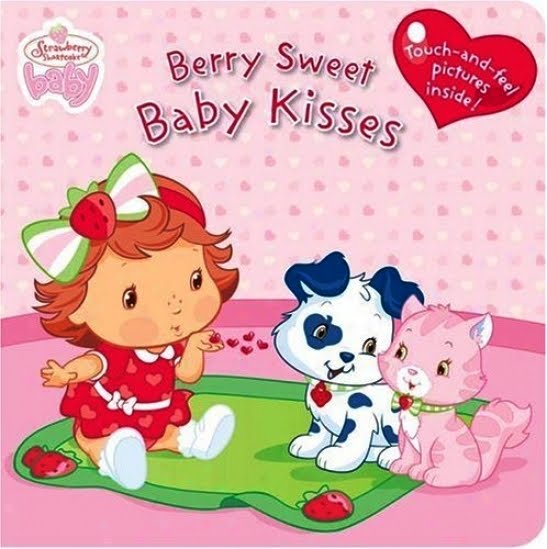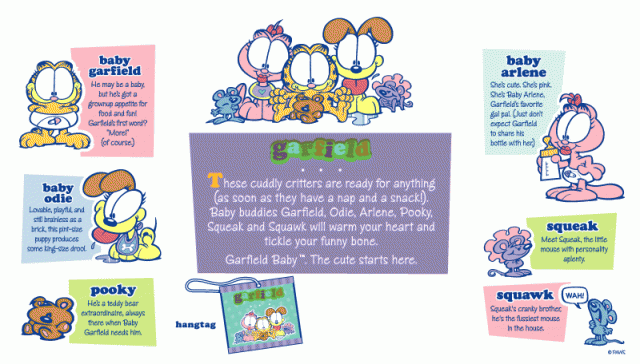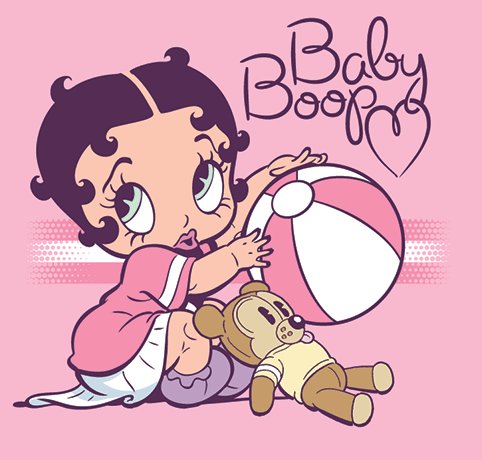Muppet Babies: An Adorable, Deplorable Legacy
Posted 9 years ago by Rob Lammle Television
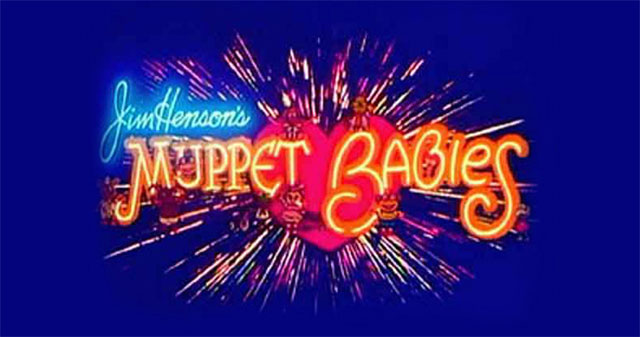
In 1984, the Muppets were on a bit of downslide. The Muppet Show had ended its five-season run in 1981, the same year the Muppets had last been on the big screen in The Great Muppet Caper. That’s not to say that Henson and company were bored by any means. 1982 had seen the all-puppet feature film, The Dark Crystal, and Fraggle Rock was introduced on HBO in 1983. And, of course, there was always Big Bird and his friends on Sesame Street to keep Muppeteers busy. But the Muppets – Kermit, Piggy, Fozzie, and the rest of the gang – were sort of off the radar at the time. They’d had a few TV specials here and there, and The Muppet Show was still being shown in syndication, but the characters were essentially shelved while Henson focused on other creative ventures.
But that all changed when their new film, The Muppets Take Manhattan, was released in theaters. It wasn’t that the film itself, which told of Kermit’s journey to bring the Muppets to Broadway, was a huge success. In fact, of the six original Muppet features, Manhattan ranks #5 with a box office take of only $25 million (Muppets from Space is #6, which should surprise no one). However, there was one scene in Manhattan that was destined to bring the Muppets back into the spotlight.
If you were alive in 1984, you probably loved this scene; I know I did. The little Muppets were adorable and the song was a catchy 1950’s throwback, complete with Fozzie, Gonzo, and Scooter backup singers. Although it is cuter than cute, if you think about it, there’s no reason for the scene to exist; it’s a dream sequence (not a flashback), and it’s inclusion doesn’t progress the story at all. It feels like a scene from another film, and there is some indication that this is not entirely by accident.
Shortly after Manhattan was released, the baby Muppets scene was spun-off as a Saturday morning cartoon, Jim Henson’s Muppet Babies. The show ran from 1984 until 1991, for a whopping 107 episodes, and earned 14 Daytime Emmy Award nominations, taking home seven. But it also spawned a ton of merchandise, ranging from toys, books, clothes, and even a comic book, surely bringing in millions for Henson.
The official story says that the show was created in response to the popularity of the scene in the movie. However, the film opened on July 13 and the cartoon debuted on September 15 – almost exactly two months later. It’s hard to imagine that anyone could put together a cartoon production, including a complete voice cast, writers, animators, and musicians, let alone get it on CBS’ fall line-up, in less than two months. Call me a cynic, but it would seem that the Muppet Babies were waiting in the wings, and just needed a good way to be introduced to the world. What better avenue than shoehorned into a major motion picture? And, hey, the idea worked, because to a generation of kids, the show has become almost as synonymous with the Muppets as The Muppet Show itself.
The Pre-Muppet Era
Even if it was a calculated decision, the concept of using a younger version of an adult character to relate to kids was not invented by Jim Henson. For example, Robin, Batman’s boy sidekick, was introduced in 1940 to not only give Batman another character to talk to (the writers were getting bored), but to also draw in younger readers. As with Muppet Babies, the ploy worked – sales of Detective Comics doubled after the Boy Wonder made his debut.
After that, nearly every 4-color hero donning a cape and mask had their own kid sidekick – The Human Torch had Toro, Bucky fought Nazis with Captain America, The Sandman had Sandy the Golden Boy, Green Arrow mentored Speedy, Aqualad swam next to Aquaman, Kid Flash ran with The Flash, and Wonder Woman had Wonder Girl and even Wonder Tot by her side. Now it could be argued that these are not technically “baby” versions of the main character. True, they are separate characters, but at the same time, even the most obsessive comic book fan would be hard-pressed to supply any major differences between the basic skillset of the master and his apprentice; the kids were essentially mini versions of the masked heroes. Regardless, the idea was to use a younger character to rope in the kiddies, acting as their proxy for the paneled adventures.
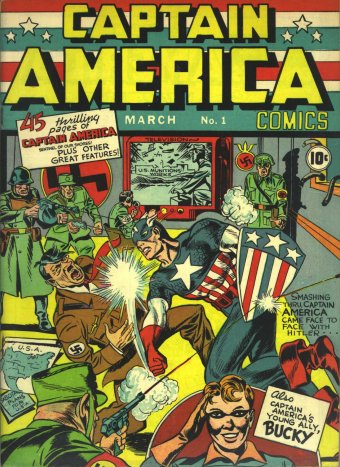
But sidekicks aside, there’s no arguing that one of the first true “kid” superheroes was Superboy. Introduced in 1944, the character was conceived as a way to tell stories from Superman’s formative years. The Superboy comic book ran continuously until 1986, and he’s had his own title off-and-on ever since. He’s still an active member of the DC Universe, and served as the inspiration for the long-running TV series, Smallville.
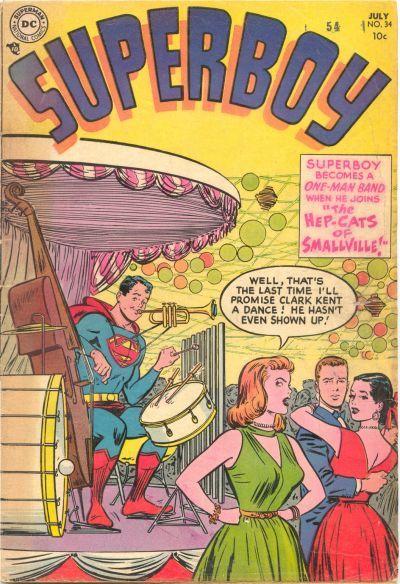
Using Superboy as a model, the characters from Riverdale High – Archie, Jughead, Betty, and Veronica – were “kid-ified” in 1956 as Little Archie, a comic book series that took the stuck-in-time teenagers and transported them back to their elementary school days. The comic remained in print for decades, lasting 140 issues, before finally being shelved in the mid-1990s, making it one of the longest-running “baby” versions of a franchise in existence.
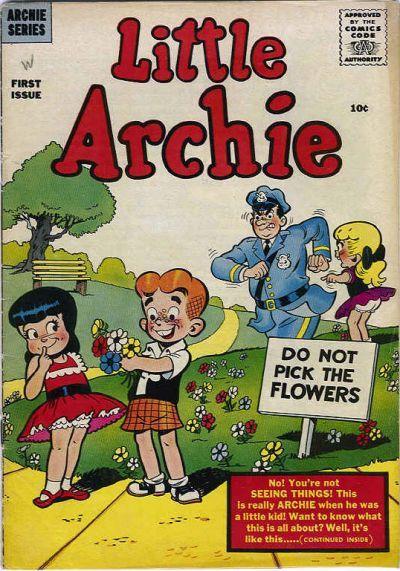
Cute Overload
So while the “younger version” idea is not new, the examples are few and far between before Muppet Babies in 1984. Since then, though, things have gotten a lot cuter; nearly every franchise you can think of had its own “baby” version at one time or another.
Disney Babies – It’s no surprise that Disney was one of the first to jump on the Muppet Babies bandwagon.
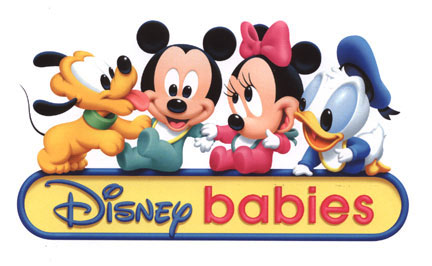
Baby Looney Tunes (2002 – 2004) – Again, to be expected. It’s actually rather surprising it took so long to happen.
The Flintstone Kids (1986 – 1988) – This was one of the first old school franchises to be resurrected with kid characters.
A Pup Named Scooby-Doo (1988 – 1991) – As if Scrappy-Doo wasn’t bad enough.
Clifford’s Puppy Days (2003 – 2004) – What’s the point of making Clifford the Big Red Dog into a normal-sized puppy anyway?
Disney’s Jungle Cubs (1996 – 1997) – Did we really need a hip-hop version of The Bare Necessities?
Baby Felix (2000 – 2001) – This is such a sad attempt at making an old franchise relevant again. I can’t believe kids even knew who the original Felix was in the first place.
Tom & Jerry Kids (1990 – 1994) – You can tell they’re kids, because Tom has a hat. Adult cats don’t wear hats, ya know?
Strawberry Shortcake Baby – Isn’t she already a little girl to begin with?
Garfield Baby – Who asked for this?
Baby Boop – Betty Boop for a new, lame generation.
Care Bear Cubs – Oh, good, deformed Care Bears.
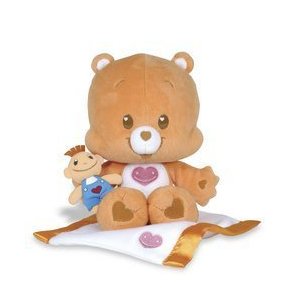
Gadget Boy (1995 – 1998) – A kid version of Inspector Gadget? Go-Go-Away, Gadget!
Sesame Beginnings – This is a direct-to-DVD series of videos for babies in the same vein as those terrible Baby Einstein videos.
Little Rosey (1990) – Mercifully, Roseanne refused to take notes from ABC execs on changes they’d like to see to the show, so the series was canceled after only one season.
The New Archies (1987) – Apparently 140 issues of the Little Archies comic book just wasn’t enough. One of the pioneers of the “baby” movement tried again with this short-lived Saturday morning cartoon.
Pink Panther and Pals (2010) – This is apparently a teenage version of the Pink Panther.
X-Men: Evolution (2000 – 2003) – Of all of the shows, this one makes the most sense, since the X-Men are trained as students at the Xavier School for Gifted Youngsters. Although it does break canon, as most of the characters on the show weren’t teenagers when they came to the X-Men. But this is minor compared to some of the other shows’ canon-busting concepts.
Tiny Titans and Mini Marvels – Since the mid-2000’s, both DC and Marvel have been publishing kiddie versions of some of their most prominent comic book properties. These titles generally take a humorous approach, similar to something you’d see in the Sunday comics section, giving kids a gateway to the characters without trying too hard to fit into the original canon.
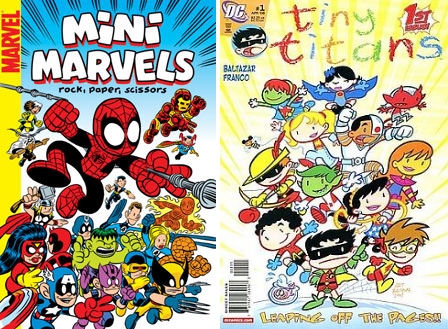
Yo Yogi! (1991 – 1992) – I saved the worst for last. The theme song alone, what with its canned rap song record scratching, is just about the worst pandering you’ll ever see. But the premise, a teenage Yogi and friends, dressed in trendy ’90s clothes, like Snagglepuss and his Dwayne Wayne flip-up sunglasses, hanging out at Jellystone Mall, makes me want to punch puppies in the face. In an attempt to be so cool, Yo Yogi! only succeeds in being utterly transparent in its crass purpose for existing.
And those are just the ones that are younger versions of the main characters. There are also “baby” franchises starring the kids of famous characters, or spin-off characters that are obviously inspired by the founders of the franchise. For example…
Tiny Toon Adventures (1990 – 1995) – This is a rare example of the concept done right. The characters were similar to the original Looney Tunes, but just different enough to not feel too derivative. Many people don’t even put it in the same category as the other shows on this list, even though it’s pedigree is pretty clear.
Bozo’s Clown Babies – Creepiest. Thing. Ever. Thankfully this one didn’t really catch on.
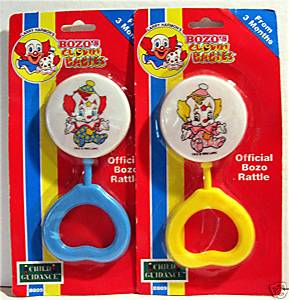
Pink Panther & Sons (1984 – 1985) – The baby, Panky, has to hold up his diaper everywhere he goes. It’s so adorable, I wanna puke.
The Oz Kids (1996) – Thankfully this is not a baby version of the HBO show. No, this one stars the children of Dorothy, the Tin Man, Scarecrow, the Cowardly Lion, Jack Pumpkinhead, the Wizard of Oz, and even Glinda, the Good Witch of the South, in their own mystery-solving series. I’m not sure I wanna know how the Tin Man and Scarecrow were able to reproduce…
The Baby Backlash
Of course there have also been a fair share of parody baby franchises that have satirized this blatant marketing ploy. One of the prime examples is Marvel’s X-Babies, a detour into pint-sizedom for the X-Men in the 1980s comic book series. The tiny team, made up of members like Wolvie, Shadowkitty, Colossusus, and Creepy Crawler, has actually become something of a Marvel staple, re-appearing more than once in subsequent years. They even faced The Mighty ‘Vengers, featuring Captain Amerikid, Iron Ace, Hawkey, and Thunderson, in 2000. The Simpsons riffed on the idea in a classic episode from season 19, “Husbands and Knives”, when Milhouse asks Alan Moore, writer of Watchmen, to sign a copy of Watchmen Babies in V for Vacation. Futurama got in on the act with the season four episode “Teenage Mutant Leela’s Hurdles”, when the crew of Planet Express falls into a pit of magical age-reducing tar and they all become teenagers.
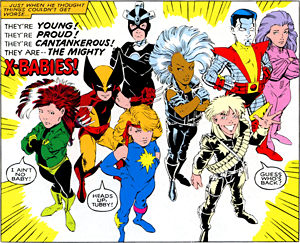
The Next Generation
You would think that after 27 years, maybe the trend would be on its way out. In fact, thanks in part to the influence on America of the kawaii and chibi cultures of Japan, which focus on cute characters like Hello Kitty, the concept is just as popular as ever, especially in the toy world. Not only are we seeing Japanese Kubrick toys of popular franchises on Toys R Us shelves, but with so much competition from the internet and video games, companies like Hasbro and Fisher-Price are doing whatever they can to capture kids’ attention. But now, instead of simply making baby versions of popular characters, they just look sqaut and more kid-friendly, so that they’re more palatable for the pre-teen set. These designs are a win-win, as there are plenty of adults who buy these figures to give their office cubicles a little personality (myself included). Today, “cute” is the new “cool.”
Hasbro has really led the way in this “cute-fication” of popular franchises. Starting in 2007, they released kid-friendly versions of Gen X standards, like Transformers (Robot Heroes), Star Wars (Galactic Heroes), Marvel Superheros (Superhero Squad), G.I. Joe (Combat Heroes), and even Indiana Jones (Adventure Heroes). The figures were wildly popular with both kids and their parents. The Star Wars, Transformers, and Marvel lines have continued with new toy sets – Jedi Force Heroes, Rescue Bots, and Superhero Adventures, respectively.
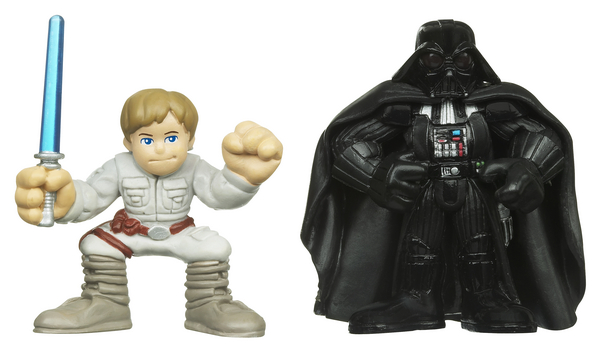
Fisher-Price has gotten in the game as well, with their Imaginext line, featuring popular DC superheroes such as Green Lantern, The Flash, Superman, and Batman. Their small, chunky figures can even make Two-Face, the hideously scarred, horribly insane villain of the Bat-franchise, look like a pretty affable fellow.
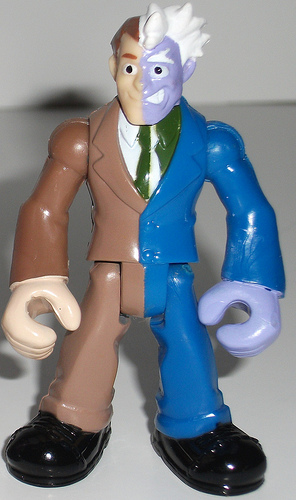
It’s not just American toys that are being adapted for little customers. Even the popular British science fiction staple, Doctor Who, has seen it’s own “kid” toys. Most prominent has been the Time Squad series of figures, which has been popular on both sides of the pond. I mean, who doesn’t need a cute, little, terrifying Weeping Angel?

Teach Your Children Well
It’s hard to believe that something as cute and innocent as baby Muppets could cause a cultural earthquake whose aftershocks can still be felt nearly 30 years later. While there have been some solid franchises born from this trend, most of these spin-offs have been nothing more than attempts to make a flailing franchise viable again. The idea worked for the Muppets and a handful of others, because the “baby” property was allowed to stand on its own, giving the creative team the freedom to do what it felt was best for the characters. The less-successful attempts left in their wake have failed because they’ve tried too hard to be hip, and cool, and of-the-moment, the obvious result of some corporate board who guided the project based upon the latest marketing research numbers. Oddly enough, it would seem that the same lesson that can be applied to raising real children can also be applied to raising a “baby” franchise – give them the freedom to be what they want to be and they’ll make you proud.
